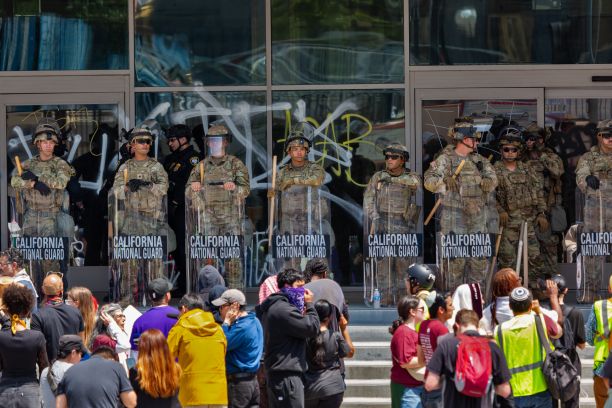
In the early summer of 2025, Los Angeles became the epicenter of a constitutional and political storm. Since June 6, protests against Immigration and Customs Enforcement (ICE) raids have swept through the city, fueled by outrage over federal immigration policies.
In response, the Trump administration, invoking an obscure provision of U.S. law, deployed the National Guard to the streets of Los Angeles, bypassing the authority of California’s governor. On June 9, U.S. Marine Corps forces joined them, escalating tensions and prompting a lawsuit from the state government.
This unprecedented move—deploying military forces to quell civilian protests—has ignited a fierce debate about the role of the military, the limits of federal power, and the erosion of democratic norms.
The protests in Los Angeles began as a grassroots response to ICE operations targeting undocumented immigrants. Demonstrators, many waving flags of Mexico and El Salvador, filled the streets, voicing their opposition to what they see as draconian federal policies. The Trump administration, citing 10 U.S. Code § 12406, federalized the California National Guard without the consent of Governor Gavin Newsom. This legal maneuver allows the president to activate the National Guard in cases of foreign invasion, rebellion, or when federal laws cannot be enforced by regular forces. Yet, the administration’s decision to equate civilian protests with “insurrection” has raised alarm bells, both in the U.S. and abroad, where such actions evoke memories of authoritarian overreach.
The National Guard, a reserve component of the U.S. armed forces, is typically under state control, deployed by governors for emergencies like natural disasters or civil unrest. Its federalization—when the president assumes control—requires extraordinary circumstances, such as a national emergency or overseas combat needs. Historically, such actions are rare and politically fraught. The last time a U.S. president federalized the National Guard against a governor’s wishes was in 1965, when President Lyndon Johnson deployed troops to protect civil rights marchers in Alabama. That context, rooted in defending constitutional rights, stands in stark contrast to the current deployment, which targets dissent in a Democratic stronghold.
California’s lawsuit, filed on June 9, accuses President Trump and the Department of Defense of abusing power and violating state sovereignty. The state argues that the deployment, ordered without gubernatorial approval, contravenes the legal requirement that such orders be issued “through the governors of the States.” The California case underscores a broader issue: when does federal intervention cross the line into overreach?
The administration’s legal justification hinges on the Insurrection Act, a law that permits the president to deploy military forces to suppress rebellion or domestic violence. However, the Act’s use is rare and controversial, reserved for extreme cases like the 1992 Los Angeles riots. In this instance, the White House has not formally invoked the Insurrection Act, relying instead on Section 12406. Critics argue this sidesteps constitutional checks, allowing the president to label protests as “insurrection” without clear evidence.
The deployment of active-duty U.S. Marine Corps forces on June 9 marked a dangerous escalation. The Posse Comitatus Act of 1878 strictly limits the use of federal troops in domestic law enforcement, except under specific constitutional exceptions or congressional approval. By sending 700 Marines to Los Angeles without invoking the Insurrection Act or coordinating with state leaders, the administration risks violating this longstanding safeguard.
The decision to militarize the response to protests has inflamed tensions rather than resolved them. Local law enforcement, already equipped to handle demonstrations, was sidelined as National Guard troops in combat fatigues patrolled Los Angeles streets. The presence of armed soldiers has fueled the protests’ momentum, with demonstrators accusing the federal government of intimidation.
The administration’s rhetoric has further muddied the waters. Some politicians have pointed to protesters waving foreign flags as evidence of an “invasion” by undocumented immigrants—a claim that stretches credulity. The protests, while occasionally marked by violence, do not meet the legal threshold of insurrection, which requires a deliberate, organized rebellion against the government.
Los Angeles Mayor Karen Bass has condemned the deployment, calling her city a “test case” for federal overreach. She argues that the move strips authority from local and state governments, undermining democratic governance. Bass’s warning that Los Angeles is being used as a political pawn reflects a broader concern: that the administration is leveraging the crisis to distract from domestic controversies, including Trump’s public feud with Elon Musk and debates over the “One Big Beautiful Bill Act.”
The timing of the deployment raises suspicions about political motives. Coming amid preparations for the U.S. Army’s 250th-anniversary parade, the move appears designed to project strength and divert attention from policy failures. Critics argue that targeting Democratic cities like Los Angeles is a deliberate strategy to inflame partisan divisions.
Within the U.S. military, the deployment has sparked unease. The armed forces have long prided themselves on remaining above partisan politics, but federalizing the National Guard to suppress protests threatens this tradition. Military leaders fear that such actions could erode public trust, casting soldiers as enforcers of political agendas rather than defenders of constitutional order.
The historical parallel to the Kent State shootings of 1970 looms large. On that tragic day, Ohio National Guard troops opened fire on anti-war protesters, killing four students and wounding nine. While today’s National Guard is better trained for civil unrest, its core mission remains combat-oriented, not crowd control. The deployment of troops untrained for nuanced civilian interactions risks repeating past mistakes.
Veterans and civilians alike have called on troops to honor their constitutional oaths over partisan loyalty. Marine veteran Janessa Goldbeck, CEO of the Vet Voice Foundation, emphasized that her oath was to the Constitution, not a president or party. Social media has amplified these sentiments, with a viral TikTok video showing a protester confronting National Guard troops: “You took an oath to the Constitution, not to the fascists in the White House.”
The deployment also undermines procedural justice. California, a sanctuary state, has explicitly refused to cooperate with federal immigration enforcement. By overriding the governor’s authority, the administration has violated the Tenth Amendment, which reserves powers to the states. Governor Newsom has warned that this sets a dangerous precedent, allowing the federal government to impose similar measures on other states.
The First Amendment, guaranteeing free speech and assembly, is also at stake. The Los Angeles protests began as peaceful exercises of constitutional rights, yet the presence of armed troops has chilled public expression. Hina Shamsi of the American Civil Liberties Union warned that deploying military forces against protesters violates constitutional limits, regardless of who carries the gun.
As protests spread to cities like Dallas, Austin, Chicago, and New York, the crisis shows no signs of abating. The administration’s next steps remain uncertain: Will it formally invoke the Insurrection Act to justify further military deployments? Could active-duty Marines be sent to other cities?
The deployment of troops in Los Angeles risks eroding public trust in the military, a revered institution in both the U.S. and Croatia. When soldiers are pitted against civilians, their role as protectors of the nation is corrupted. Former Defense Secretary Lloyd Austin once emphasized that the military must “stand apart from the political arena.” By labeling protests as insurrection, the administration undermines this principle, threatening the foundations of American democracy.
The crisis also raises broader questions about the militarization of governance. When a president claims, as Trump did, that “the bar is what I think is,” the rule of law is replaced by personal whim. The arbitrary expansion of “national security” to justify military action sets a precedent that could reverberate beyond U.S. borders.
Ultimately, the Los Angeles crisis is a test of democratic resilience. It challenges the balance between security and freedom, federal and state authority, and military and civilian roles. As the U.S. grapples with these tensions, the world watches, aware that the outcome will shape not only American democracy but also the global conversation about power and protest.
The protests in Los Angeles, and the military response they provoked, are a warning: when dissent is met with force rather than understanding, the social contract frays. This moment underscores the need to safeguard civil liberties and resist the temptation to militarize political disputes. As the U.S. navigates this crisis, its choices will echo far beyond its borders, offering lessons for democracies everywhere.

